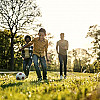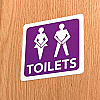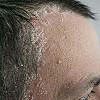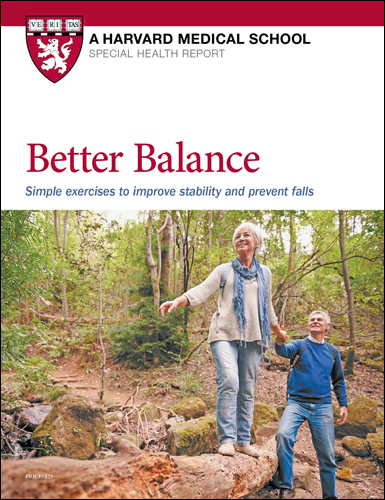
Stepping up activity if winter slowed you down

Common causes of cloudy urine

Dragon fruit: How to enjoy this antioxidant-rich fruit

Are you getting health care you don't need?

Could you benefit from wearing compression socks?

A low-tech school vacation: Keeping kids busy and happy without screens

Mold in the home: Identifying and treating the issue to prevent health problems

Effective, practical strategies for coping with urinary incontinence

Scalp psoriasis: What to know about this uncomfortable inflammatory skin condition

Measles is making a comeback: Can we stop it?


Preventing Falls
Keeping your balance and preventing a fall just got easier, thanks to Preventing Falls, from the experts at Harvard Medical School. This information-packed guide explains how your body works to keep you balanced, and the health problems, medications, and home-hazards that can set you up for a fall. And it provides specific ways to help you improve your balance and maintain your mobility.
Other Product Information
Every 11 seconds an older person in the U.S. is treated in an emergency room for a fall-related injury.
The good news is that many falls can be prevented. For the best ways to maintain your balance and avoid falling get Harvard Medical School’s new report Preventing Falls. This information-packed guide from Harvard’s expert physicians explains:
- Why we’re more likely to fall as we age
- The specific risk factors for falling
- The “right” way to fall to reduce your chances of injury The secrets to preventing falls — from improving your health to exercises that improve strength and balance
But the risk factor most likely to predict a future fall is a previous fall! Chances are you don’t remember you’ve fallen unless you are injured. You might trip over the edge of a carpet … Twist an ankle as you step off a curb … Or stumble over a box in the garage. They seem like small problems, but as you’ll soon discover in Preventing Falls these are all signs you need to be more careful to prevent a serious fall.
Start reading Preventing Falls right now and discover how to reduce your chances of falling and the best ways to maintain your mobility and improve your balance, including:
- The vision problems that can make you more likely to fall
- 3 ways stiff joints put you at risk for falls
- Exercises that help boost core strength and improve balance
- Two types of exercise that can help keep ankles—an important joint for keeping you steady on your feet—strong and limber
- Why you should walk slowly and make sure you hold railings if you have a head cold or flu
- The type of yoga that is best at reducing falls.
Plus, you’ll even get an at-home guide to preventing falls with 57 room-by-room tips to fix the fall hazards lurking in your home.
Don’t risk a serious fall when Harvard Medical School’s Preventing Falls has the answers you need for improving your balance, maintaining your mobility, and staying steady on your feet.
Prepared by the editors of Harvard Health Publishing in consultation Howard E. LeWine, M.D., Associate Professor Medicine, Harvard Medical School. (2021)
About Harvard Medical School Guides
Harvard Medical School Guides delivers compact, practical information on important health concerns. These publications are smaller in scope than our Special Health Reports, but they are written in the same clear, easy-to-understand language, and they provide the authoritative health advice you expect from Harvard Health Publishing.
The life-altering consequences of falling
Falls are common because the risk of falling presents itself in so many aspects of daily life. Routine acts—such as getting out of bed, going to the bathroom, taking a shower, or getting in and out of a tub—can be far riskier than most people realize. Losing your balance and falling can mean just a few bumps and bruises, or more serious injuries that require hospital treatment. In some cases, a disabling fall or repeated falls may make independent living untenable, resulting in a move to a nursing home. In the United States, unintentional falls are also the No. 1 cause of injury-related deaths among adults ages 65 and older.
Fractures
While broken bones in the limbs are a very common injury from falls, hip fractures are considered the most serious types of fractures—often resulting in permanent disability and sometimes death. The risk of hip fractures increases with age. Each year, according to U.S. government hospital surveys, more than 318,000 people over 65 are hospitalized for hip fractures, and more than 88% of hip fractures occur as a result of falls. Hip fractures often lead to premature death.
Traumatic brain injury
Falls are the single most significant cause of traumatic brain injury, leading to nearly half of hospitalizations for this type of injury. Brain injuries can result from something as simple as tripping on a sidewalk or falling in the shower. They can lead to permanently impaired mental abilities and emotional instability. Brain injuries also have been linked to a higher risk of developing dementia. The initial symptoms of a traumatic brain injury may occur immediately or may be delayed for many hours after the fall.
Neck injuries
Falls can also involve the neck, producing a range of injuries from mild to serious:
Strains and sprains. The former affects the muscles, and the latter is an injury to the ligaments. Strains and sprains are among the less serious—but still painful—neck injuries that commonly result from falls.
Herniated disc. This type of injury happens when the cushion between two spinal bones (vertebrae) is squeezed out of position, often putting pressure on a nerve where it exits the spine. Injuries can result from a sudden twist or jerk of the neck that may occur during a fall.
Fracture of the cervical spine. Among younger people, these bones in the neck often can be fractured by a hard impact or long fall. Less force is needed to produce fractures in older people whose bones have begun to weaken.
Cervical dislocation. This type of serious injury occurs when the bones of the neck are pushed out of alignment, usually by a fracture. It requires immobilization of the neck and immediate medical care (often surgery) to prevent damage to the spinal cord.
Spinal cord injury. This is by far the most serious of neck injuries. It usually results from a neck fracture, dislocation, or both. Spinal cord injuries in the upper-most region of the spine are generally fatal. Patients who survive usually develop paralysis of the arms and legs and may need the assistance of a breathing machine (respirator).
Back injuries
Tripping or falling a short distance can cause back injuries as a result of the impact itself or excessive twisting of the spine. They may simply cause temporary back pain. But older people are more likely to suffer vertebral compression fractures, nerve compression, or damage to the spinal cord. These injuries can cause extreme pain or pressure in the neck, head, or back; tingling or numbness in the arms and legs; and difficulty with walking or balance.
Eye injuries
Not only does poor eyesight contribute to falls, but falling is a common cause of trauma to the eye and its surrounding structures, such as bruising (black eye) and fractures of the orbital bone. A 2021 study found that older U.S. adults suffer nearly 1,400 fall-related eye injuries each year that lead to an emergency room visit. Fall-related injuries to the eye were 23 times as likely to lead to a hospital stay as eye injuries not related to falls.
Fear of falling
One of the unrecognized consequences of falling is the emotional toll it takes. Even if people don’t have a lasting injury due to a fall, they are likely to develop a fear of falling in the future. Such a fear can lead to anxiety and an overuse of caution in daily situations. People who have fallen might start to avoid activities they previously enjoyed.
Fear of falling may be rational, but it’s not helpful. It can restrict your regular activities and cripple your independence. When faced with an unsteady situation, you’re likely to stiffen your body in anticipation of falling. This can actually make falls more likely by impeding your mobility and balance. You’re also more likely to get hurt if you fall.
- But it was just a fall!
- Why people fall
- Maintaining general health to prevent falls
- Maintaining your mobility
- Exercise to help prevent falls
- A research-tested program
- How to fall without injury
- Preventing falls at home and work
- Resources
You might also be interested in…

Better Balance: Simple exercises to improve stability and prevent falls
Discover how you can prevent falls by improving your balance and mobility. Better Balance: Simple exercises to improve stability and prevent falls gives you step-by-step instructions for easy, effective workouts that will improve posture, increase muscle strength and speed, sharpen reflexes, expand flexibility, and firm your core. You'll also get tips for fall-proofing your home.

Stepping up activity if winter slowed you down

Common causes of cloudy urine

Dragon fruit: How to enjoy this antioxidant-rich fruit

Are you getting health care you don't need?

Could you benefit from wearing compression socks?

A low-tech school vacation: Keeping kids busy and happy without screens

Mold in the home: Identifying and treating the issue to prevent health problems

Effective, practical strategies for coping with urinary incontinence

Scalp psoriasis: What to know about this uncomfortable inflammatory skin condition

Measles is making a comeback: Can we stop it?
Free Healthbeat Signup
Get the latest in health news delivered to your inbox!
Sign Up

